Hi Silvia, tell us a little about the story ... how the idea of RaB bar was born, the reason that led you to create this reality.
It all comes from our experience of volunteering in the Handicap association ... up your head! of Giambellino. The association carries out recreational activities for children with intellectual disabilities.
Basically, the idea is to spend time together, have fun, have fun.
In 2011 we created the Baracca Laboratory, where once a month we managed an evening within the Arci Biko club. 16 people including volunteers and the disabled who organized concerts, exhibitions, where everyone collaborated in the success of the event.
The goal has always been to not make the children mere users of the activities, but to be the proactive part, the actors of the events so as to empower them, give them a sense of planning, make them feel part of something that is enjoyed by others and appreciated.
Since those evenings, 5 of us have decided to embark on a more ambitious project. In particular, me and Valentina (the other partner) took care of the all-round management of the implementation of the new business, with the contribution of the Vismara Foundation and the Intesa Sanpaolo Foundation. And here we are today!

How did you come to the name of the place?
The name, I think, was one of the hardest things to decide. It's like when you have to choose a name for your child. It must make sense, you spend time on it.
We have landed at RaB, simply the opposite of bar, an upheaval, a bar outside the box. In fact, under the name we put a Magritte quote from "this is not a pipe" to "this is not a bar".
Even the logo, as you can see, takes up Magritte's eye. We like surrealism, not only as an artistic current, but as a displacement of points of view, of perspectives, which very much recalls what happened to us, as volunteers, being with these guys. We have been contaminated by their outlook on life.

How does the context of disabled people fit into RaB?
The guys work in the club with us. At the moment there are 5, plus 6 "able-bodied" people. While during the winter, due to the greater influx of customers, we have extras that help us, and there are also some who are doing an internship. From the latter point of view, we have received several applications. RaB is very attentive to the person, therefore, for them to carry out a career growth path, and not only, is very interesting.
Social intent is very present, but it is not just aimed at young people. It is a two-way "social contamination", we got involved in their way of seeing life, they feel part of a bigger project, and even our customers, coming here simply to eat a sandwich, leave the more enriched premises with new and different perspectives.
What we try to do with our business is to be attentive to the person in front of us, regardless of who he is. Listening to the other, understanding their weaknesses, making use of their potential.

On your site we noticed the events section. What are the guidelines of artistic programming? How do you select the artists? Basically, how do you structure the program?
One of the ideas behind RaB is to be a place of "co-construction". For us, RaB reaches its maximum beauty "when people feel a little at home". It often happens that they leave us “pieces of their own” - a painting, a drawing, a book - which join our collection today from all over the world.
Right now there is the exhibition of Nicholas, one of the guys who works with us. That big picture you see on that wall is under construction, and it's his work. To create the work, each person who passed by the room had to write 3 things on a sheet that would lead to an ideal world, and post them in a box. Nicholas later read everything that everyone had written, drawing pictures of what had been written on the canvas. This was the ideal world of those who had switched to RaB.
It is nice to give voice to different expressions of art, because there are different people.

Joining RaB means being part of a thought, sharing an ideal.
Absolutely. Although we often realize that as a first impression, the customer appears a bit disoriented, in the sense that he is unable to identify RaB well.
Different personalities and ideas that coexist. One day you find Paolo Conte on the radio, the next day Kumba Music.
We noticed the creative flair in the furnishings. Recycled material, which is very close to the philosophy of WAMI. Tell us about it?
Basically, all you see are materials and objects recovered from the most disparate places: markets, the ironing board you see outside we have recovered from the side of the road. Recover, fix, sandpaper, repaint… et voilà, our original furniture that tells stories!
Even in the recovery of furniture you learn to be part of RaB.
The lamps you see above the counter, for example, come from the farm of one of our partners, and were used in the incubators of the chicks (obviously the bulbs are different, otherwise you know what I consume!). There on that piece of furniture, you can instead see an old radio… my grandmother's legacy!

That horn, up there, is the first piece we recovered for the club, which as you can see now serves as a lamp.
Do you see that sign there "Chuk" ?! Well we liked it a lot, it was about to become the name of our place, before RaB leapt into our minds. Did you know that it is a small village in Veneto?
